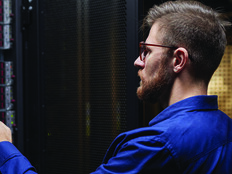Speeding Through Space
The International Space Station represents the epitome of international cooperation, human ingenuity and modern technology. For more than 10 years, the low-Earth-orbit ISS research facility has been the well-appointed home away from home and workplace for more than 100 astronauts as it has orbited its way more than 57,000 times around the Earth.
It did lack one important modern amenity, however: any Internet connection or user-controlled spacecraft-to-Earth link. In fact, the synching required for transmitting e-mail messages between onboard computers and the ground (and vice versa) created severe latency.
Because of that, the wait for an upgrade to an Internet connection, which took place in 2010, was nearly "unbearable," says Stephen D. Hunter, NASA's computer resources manager for the Space Station, which is managed from Johnson Space Center in Houston.
For astronauts, that meant no real-time e-mail or news. They could not keep up with friends and family on Facebook, peruse the web or entertain themselves during off-hours with late-night comedy clips or YouTube videos.
Psychologically, this type of isolation takes a toll on space travelers, says T.J. Creamer, a NASA flight engineer who served aboard ISS expeditions 22 and 23. And because morale is critical to mission success, NASA decided to do something to bolster it.
After looking into possible options, IT officials decided to implement virtual desktops using Citrix XenDesktop, combined with Citrix Branch Repeater, a WAN optimization technology that provides local caching. Known as the Crew Support LAN, the solution, says Creamer, "has taken us from something that was unusable to something that is now very usable," enabling the high-speed wireless connection necessary for e-mail, surfing the web, listening to music, watching videos and interacting digitally with friends and family.
The success of the initiative propelled NASA engineers to think about how they could enable even faster connectivity — with additional IT and communications enhancements in the offing that will significantly increase network bandwidth to and from the Space Station — and helped sell the Johnson Space Center generally on desktop virtualization.
"It's definitely got us thinking about different ways to impact our own infrastructure here at JSC with virtual desktops," says Preston Broesche, a NASA information technology manager and security officer who worked on the ground infrastructure of the Crew Support LAN (CSL).
Johnson Space Center has long relied on virtualized servers but now is looking at how it can make use of zero clients, Broesche says. "There's a real cost benefit to that, and so we're seeing if we can actually leverage some of this work we've done on the Space Station to actually help the center out as well."
Small Step, Giant Step
When NASA first began looking at how to provide a faster wireless connection to Space Station astronauts, they realized that their options were limited by unique logistics. They couldn't make a major hardware change because it would be too expensive and logistically challenging to fly the equipment up to low-Earth orbit.
Moreover, any solution chosen couldn't weigh much, it had to be reliable in the Space Station's unique ionizing radiation environment, and it couldn't require much storage of spare parts. Furthermore, IT officials didn't want to rely on anything that required extra training for the astronauts, who already have enough demands placed on them.
"A software solution just made the most sense," says David Chiquelin, a senior computer developer for NASA. "We have laptops on board that astronauts are familiar with and that are stable in that environment, so it was very convenient to be able to rely on the hardware we already had and combine it with a software solution, which would allow us to have more rapid deployment."
Ultimately, virtual desktops proved to make the most sense. With this type of solution, the applications and data reside in a data center at Johnson. Astronauts simply log in to receive a familiar Microsoft Windows desktop experience that is personalized to each user.
"These are all images that we actually use on the ground, and that everyone knows and is comfortable using," Broesche says.
The arrangement also provides added security. When astronauts surf the web, they remain behind the Johnson firewall, which "enables really world-class safety from the risks associated with the Internet," Broesche adds.
The virtual desktops and the WAN optimizer were put in place last year, and Space Station astronauts now enjoy connection speeds of 10 megabits per second on data they send out. This is possible because only new data transmits over the wireless connection.
"All the work is done by the ground box, and the only thing that's being sent to the Space Station is a screen refresh of what's changed," Creamer points out.
Data transmission back up to the Space Station is a bit slower, achieving just 3Mbps per second, Hunter says. That's because the data has to travel several hops. From Johnson's internal network, data first goes to high-gain microwave ground terminals at the White Sands Test Facility in New Mexico, then up to the Tracking and Data Relay Satellite System in geosynchronous orbit and finally to the Space Station.
The IT team is working to improve that latency with a series of enhancements to increase speed both up to and down from astronauts. Already, some tweaks to transmission settings at White Sands have decreased the round-trip time from 1.6 seconds to 0.8 second.
Still other improvements will boost bandwidth capacity: an upgrade to the onboard systems, which will raise the rate at which information can be received and processed; enhancements to the avionics infrastructure and communications boxes on board the Space Station; and tweaks to the ground communications infrastructure. Eventually, the team wants to achieve 24Mbps in uplink speed and double the download speed from 150Mbps to 300Mbps, within which CSL will increase its speed from 10Mbps to 20Mbps for Internet access.
For the IT staff who worked on the project, the technological issues were routine. The logistics involved created the more difficult proposition.
"The challenges we faced were more in the unique communication paths that we had to go through to make everything sync, to make sure certificates were handed up appropriately and our overall communications link," explains Chiquelin, noting that to do this, the team had to find a way to upgrade parts of the onboard communications systems, including the network routers. "It made it a little more difficult because you're not directly there doing it yourself."
With the Crew Support LAN in place, data now travels more than 100,000 miles round trip from the International Space Station in low-Earth orbit to the ground boxes at Johnson Space Center in less than 1 second.
Beam Me Up
For NASA, the decision to adopt the virtual desktop was ultimately about practicality. But other agencies (including NASA for its more ground-bound functions) are finding it a good fit under many circumstances, says Shawn P. McCarthy, a research director for IDC Government Insights. With all data stored on and accessible via the backend, the approach delivers on a number of government IT desires, including cost savings, reduced maintenance, data security and mobility.
"The only thing I've seen that may stop a very rapid migration among federal agencies in that direction is that end users don't always want to give up that PC and their data," McCarthy says. "They may not be able to have that same level of hierarchical control that they're used to. But I think if agencies address that effectively, then adoption of the virtual desktop will be very high within the government."
Of course, that's not been an issue with Space Station residents, who are just grateful to finally have access to the same 21st century communications and networking tools that those on terra firma do. Creamer says that the Crew Support LAN serves only to enhance NASA's ability to achieve its mission, along with that of its international partners.
"This solution gives the Space Station crew an opportunity to reach out — as well as reach in — meaning they can get the information they need or make the connection they want at the time that they make the request," Creamer says. "That's makes everyone happier, and the bottom line is, a happy crew member is a productive crew member."







